Knowing how to use ChatGPT prompts for research paper writing can save you hours of work and improve the quality of your texts. Instead of struggling with writer’s block, you can generate ideas, analyze data, summarize sources, refine arguments, and edit your text with ChatGPT. Research paper writing can become far more efficient when you harness AI’s potential to your advantage.
However, making the most out of this advanced AI model requires more than just typing in random queries. You need a well-crafted ChatGPT prompt for research paper to get relevant and precise responses.
Want to learn more? Keep reading this guide. Here, our experts have gathered the best ChatGPT prompts for academic writing to help you:
- Generate topic ideas
- Develop a structured plan
- Narrow down your research focus
- Identify gaps in your outline
- Gather relevant sources
- Discover case studies for analysis
- Condense key information from texts
- Interpret statistical data
- Revise while drafting
- Craft a concise abstract
- Properly format citations and references
🔍 Is ChatGPT Good for Research?
In general, it’s possible to use ChatGPT as a research assistant. But the question is, for what end can you use it?
Well, if your aim is not to generate an entire paper but rather to make some of the routine writing steps easier, then using an AI tool can be ethical and permissible.
For instance, you can use ChatGPT to:
- Search for information,
- Rewrite complex ideas,
- Summarize longer texts,
- Develop research questions,
- Create research paper abstracts,
- Generate sample outlines.
ChatGPT is very effective when it comes to handling such tasks. It’s also absolutely legal to use it for these purposes.
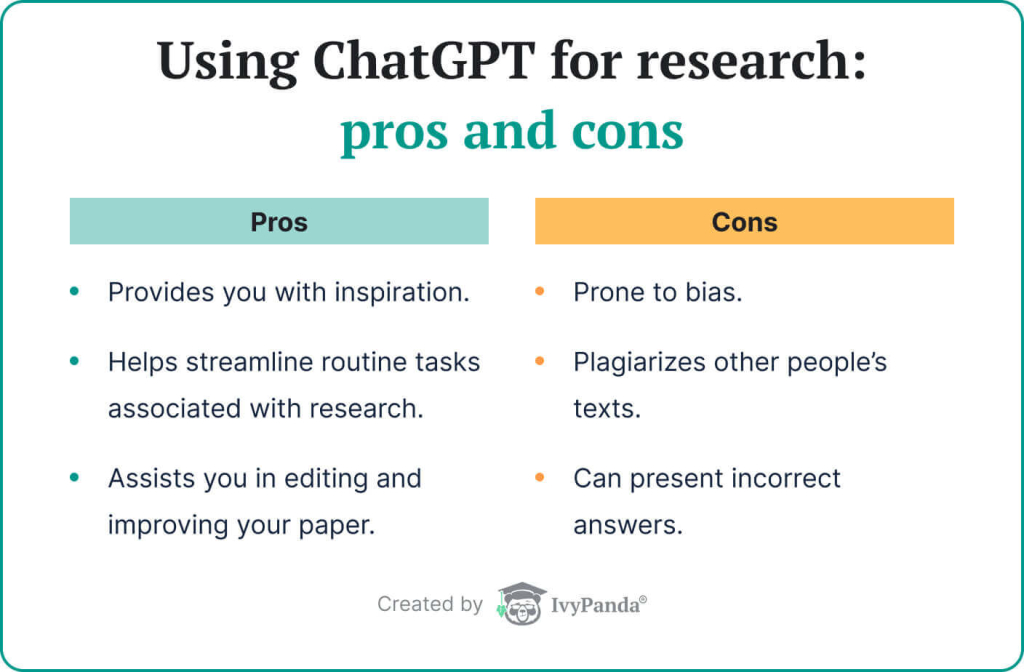
All you need to do is write a very clear prompt. Otherwise, the chatbot might give you an irrelevant answer. We’re going to share the most effective prompts for various research purposes in the following sections.
But first, an important disclaimer:
We’re firmly against AI cheating, and we don’t encourage it in any shape or form. That’s why this guide will talk about legal and honest ways to use AI for research assistance.
✍️ Limitations of Using ChatGPT for Research
If you decide to use the chatbot for your academic work, it’s essential to consider its limitations. This will help you focus on what AI does best and avoid trusting it with things that can ruin your research.
Here are the main limitations you want to consider:
- It’s limited by the datasets. Because ChatGPT is not trained on recent data, it has no knowledge of the most up-to-date information or findings in specific fields.
- It lacks depth. While the chatbot can effectively summarize information, it may fail to fully grasp complex theories and arguments of a research topic.
- It tends to plagiarize. When ChatGPT generates its texts, it rehashes the information from its database. So, even if a text seems original, it contains other people’s ideas.
- It struggles with contextualizing and interpreting data. The chatbot lacks the human ability to analyze and contextualize information critically. It needs guidance through concrete, well-written prompts.
- It can present incorrect answers. Sometimes, the chatbot simply lacks information in a specific research field. This leads to inconsistencies and inaccuracies in the generated content.
- It’s prone to bias. Since ChatGPT is trained on online data that often includes biased and offensive information, it can generate statements expressing bias towards specific ideas or people.
- It’s associated with cheating. Some unethical researches generate entire papers without making any real effort. If students do the same, they will be caught with the help of GPT Essay Checkers and punished for cheating.
Even though it may be tempting, it’s best not to rely on AI too much if you want to conduct good research. You can use some of the chatbot’s functions to make the process easier, but you still have to do most of the work yourself.
🎯 How to Use ChatGPT to Write a Research Paper: Top 11 Ideas
So, do you want to know how to use ChatGPT to write a paper? If you do, look no further!
The following list of tips will explain to you how to:
- Brainstorm topics,
- Create a roadmap,
- Refine your research topic,
- Find gaps in your outline,
- Locate sources,
- Find cases to explore,
- Summarize texts,
- Analyze statistical data,
- Edit as you write,
- Create an abstract,
- Format the references.
We’ve also included examples of the most effective prompts for each research aspect. Feel free to try them out!
1. Brainstorm Topics with ChatGPT
For many students, the most challenging part of research is the beginning. Sometimes, you just don’t know what to focus on. In situations like this, ChatGPT can help you brainstorm ideas and collect information.
Let’s assume you need to write an essay about pop culture and modern art, but you need help figuring out where to start.
The first step would be to create a good prompt for the chatbot. For instance, you can phrase your request like this:
The second step will be to choose one topic from the generated list and ask ChatGPT to tell you more about it.
For instance:
You’ll get a detailed answer on the subject.
Lastly, you can use the most interesting points from the last reply to narrow down your topic even further or to get more ideas for the direction of your paper.
For example:
And now you have fresh, focused topics that you can research.
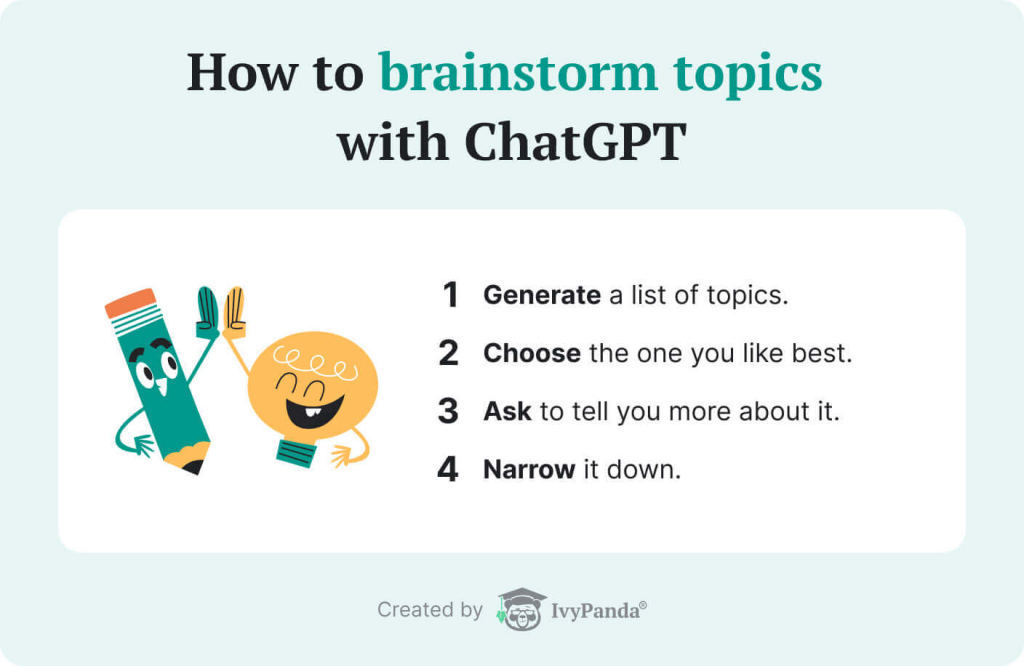
2. Use AI to Create a Roadmap
Once you’ve chosen a topic, you can use ChatGPT to create a detailed roadmap that will guide your research and help you stay on track.
As we’ve mentioned before, when you work with ChatGPT, a good prompt is the key to getting a relevant answer. This is especially true for generating outlines and roadmaps. The more detailed and clear your prompt is, the better outcome you will get.
Here’s an example of what your request might look like:
The roadmap also included suggestions for a literature review, methodology, case studies, discussion, and other essential research components. You can use all this information to create an outline.
We also suggest you research the topic before using AI. That way, you’ll have a general understanding of the subject and will be able to judge the quality of the generated roadmap.
3. Refine Your Research Question with AI
Any research needs a central question. Sometimes, it may be hard to collect your thoughts and come up with an interesting issue to focus on. In this case, you can use ChatGPT to assist you.
Here’s how:
- Describe the topic of your paper clearly and concisely.
- Ask the chatbot to suggest several research questions based on your requirements.
- Choose the best one.
Your prompt can look like this:
Tip: We also recommend using our free question generator from text. It will easily turn your research idea into a question without you having to come up with elaborate prompts.
4. Ask ChatGPT to Identify Gaps in Your Outline
Suppose you’re done with the outline and have the research question, but you feel something needs to be added to it. In that case, you can use ChatGPT to identify the gaps in your research plan.
Here’s what the prompt may look like:
5. Use the Chatbot to Find Sources
Once you have completed the preparation stage, it’s time to find suitable sources and start researching.
How can ChatGPT help you with it?
Well, one way is to ask ChatGPT to create a list of references on the subject. However, this is a bad idea since you’ll only get a list of nonexistent sources vaguely related to the central theme of your research.
Instead, we suggest you ask ChatGPT to locate relevant works on separate points from your outline. This will allow you to get a comprehensive overview of diverse aspects related to your topic and not just the central theme itself.
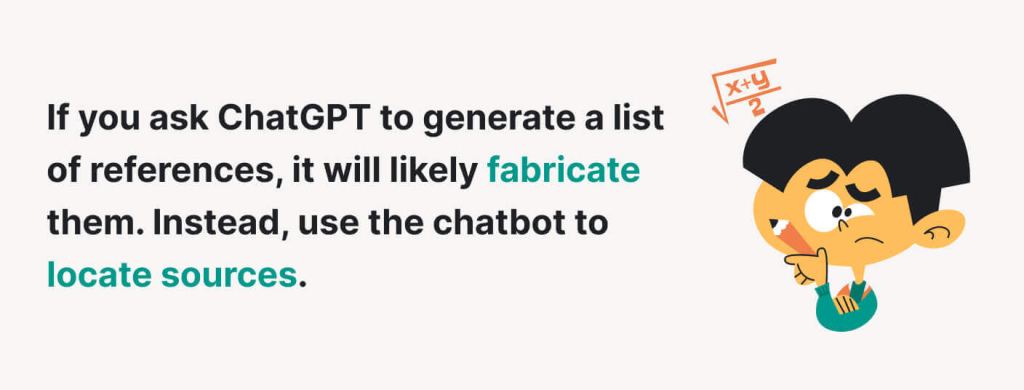
For instance, if the topic of your paper is the semiotics of memes used in modern art, one of the points in your outline can be dedicated to the visual language in memetic social commentary. Suppose this part of your research will be about 3 pages long.
So, you can ask the chatbot the following:
One thing to note is that ChatGPT can’t provide you with internet links, so you’ll have to look for sources on your own. And while you do that, you may also come across interesting articles or get new ideas that you can use to perfect your outline.
6. Find Specific Cases to Explore
Think your research lacks depth? Try adding to it real-life cases or specific historical incidents. They will help you support your statement, better convey your ideas, and add credibility to your paper.
If you want to include an example in your paper but struggle to think of one, you can use ChatGPT to look for a specific event or real-life instance related to your topic.
Here’s what the prompt can look like:
The results also included Brazilian, South Korean, and French memes with explanations. We’d say that’s enough to create a comprehensive overview. Just make sure to fact-check the generated examples and see if they actually exist.
7. Use AI to Summarize Lengthy Sources
If you need to learn the main idea of a lengthy passage quickly, you can use ChatGPT as a summarizer. This can be especially helpful when you’re working on a literature review and need brief descriptions of your sources.
Let’s try it with an article on the semiotics of memes:
When you need a summary, it’s best to provide the chatbot with the whole text by copy-pasting it. It’s important because if you use vague prompts with only the work’s title, the tool will either refer to a nonexistent work or refuse to answer the request:
Tip: In addition to ChatGPT, try using our key points maker. It will present all the necessary information from the text in a convenient list format. And if you need to create an overview of previous research for your paper’s introduction, use our background of the study generator.
8. Analyze Statistical Data with ChatGPT
Now, what should you do if your research includes statistical data? Sometimes, it can be hard to interpret numbers and connections between them. Luckily, ChatGPT can help you analyze and organize it, isolate the most critical pieces of data, and create a comprehensive summary.
To make it work, ensure that your prompt is as detailed as possible. You will also need to include the entire dataset in it.
Here’s an example:
The chatbot can also use inferential statistics methods such as chi-square tests or ANOVA, but that would require large, concrete numbers.
Otherwise, the chatbot will get stuck repeating the same formula:
Another important thing is not to rely on AI entirely when it comes to statistical analysis. The reason is that the chatbot can overlook certain things or give biased results. In some cases, ChatGPT usage for data analysis can lead to p-hacking, which is highly unethical.
What does this mean, exactly?
Well, p-hacking is a way of misusing data to create a statistically significant result when, in fact, it doesn’t exist. This leads to false conclusions and undermines the reliability of the study. For that reason, it’s crucial to analyze the data yourself and carefully double-check the results if you decide to delegate the task to AI.
Still, ChatGPT works effectively when it is necessary to summarize data or conduct a preliminary analysis of the statistical data and make conclusions depending on the study findings.
9. Use the Chatbot to Edit as You Write
While working on your paper, you may want to improve or edit its parts. That’s another aspect where ChatGPT will come in handy.
Here’s what it can do for you:
- Simplify the language. Some people use the tool to make their text more complex and formal, but more often than not, it only makes it unreadable. Simplifying it is a much better option.
- Shorten long or complex sentences. Using short sentences will help you create a more cohesive and reader-friendly paper.
- Substitute certain words with synonyms. This is especially useful when you want to say something complicated in a few words.
- Check your grammar. It’s always a good idea to proofread your paper to make sure everything runs smoothly.
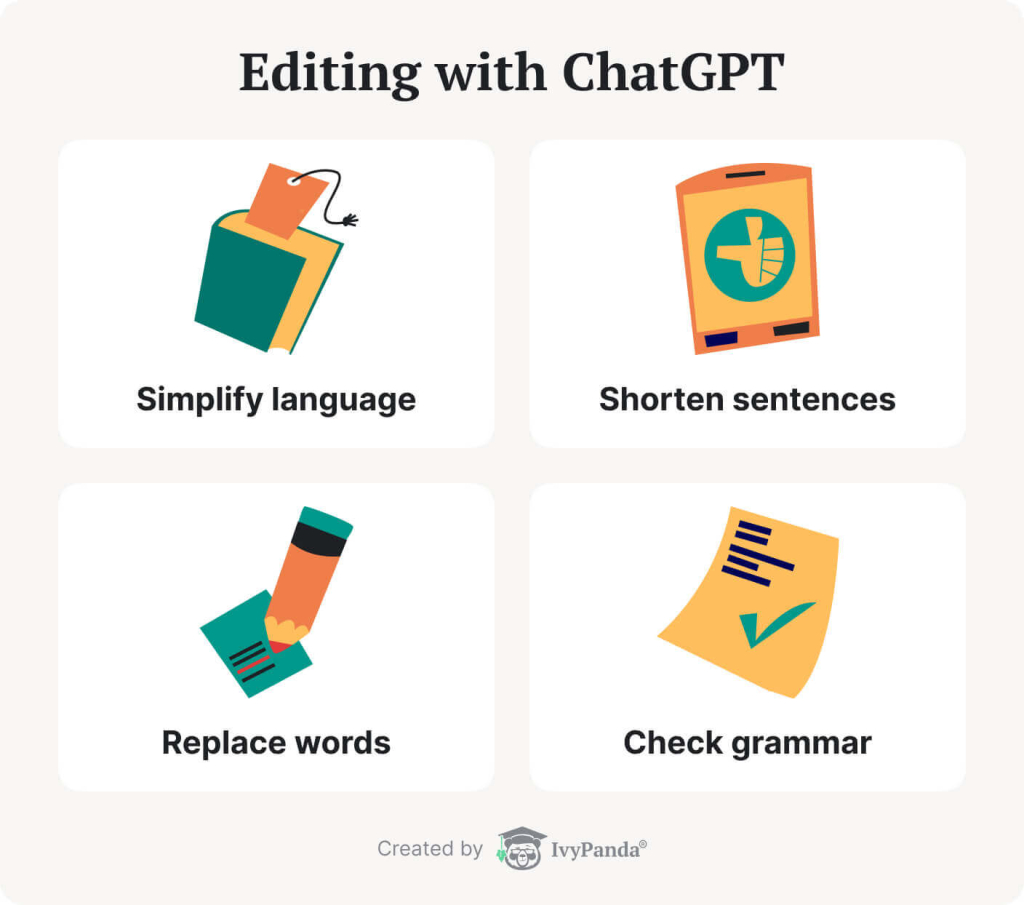
Take a look at this text:
Within the contemporary art landscape, memes are used as agents of cultural discourse, where their inherent capacity for humor and cultural resonance help address the challenges of modern society. Memes fuse visual and textual elements, which allows them transcend traditional artistic mediums, thus offering artists a dynamic platform for critiquing current socio-political events. This combination of digital vernacular and artistic expression not only blurs the boundaries between high and low culture but also reflects the evolving nature of expression in the digital age.
It sounds overcomplicated, but we can improve it with the help of Chat GPT:
Want to know more? Check out our comprehensive guide on using ChatGPT to edit essays.
Tip: We recommend listening to the text of your research paper with our essay reader tool. This will help you effectively notice any inconsistencies, difficult wording, or confusing grammar patterns.
10. Create an Abstract with AI
When you’re done with the bulk of your research and have little time to work on your abstract, ChatGPT can be a real lifesaver.
Copying and pasting the whole paper into the chatbot may not be the best idea since the AI can miss important information and not include it in the abstract. Instead, it’s best to ask the tool to create short summaries for each section of your work.
What you need to do is start a new chat and use the following prompt with each portion of your text:
After that, you simply combine the summaries to create an abstract. You use ChatGPT to help you structure it with this prompt:
Note that the generated abstract contains phrases typical for ChatGPT, like “delves into.” If your professor decides to check such a text for AI, it will most probably be marked as suspicious. That’s why it is not a good idea to submit it as it is. Consider rewriting such an abstract manually or using an AI humanizer to quickly add a human touch.
11. Use ChatGPT to Format Your References
Creating a list of references is an essential part of any research. It’s also one of its most challenging and time-consuming aspects. After all, each formatting style has numerous specific characteristics that can easily get confused.
ChatGPT can save your time and help avoid unnecessary mistakes while citing the sources. The most important thing is not to ask the AI tool to generate references from scratch.
Instead, we recommend you find all the necessary data for the references yourself. Then, manually input these data into ChatGPT and ask it to create a reference for you. That way, you’ll ensure everything is formatted correctly and avoid citing nonexistent works in your paper.
🤔 Research Aspects AI Can’t Help You With
The list of research aspects ChatGPT can help you with may look very impressive, but don’t let it fool you! There are still plenty of things that shouldn’t be entrusted to AI tools. It’s essential to know about them since ChatGPT can easily make its users overestimate its abilities regarding research, writing, and editing.

Let’s see why you shouldn’t trust AI with the following:
- Experimental design and methodology,
- Moral reasoning,
- In-depth data analysis,
- Comprehensive literature review,
- Peer review and personalized guidance.
Experimental Design & Methodology
ChatGPT can do many things, but it still lacks the nuanced understanding and the expertise to design experiments and choose the correct methodology. The chatbot can suggest some general ideas or set the direction for your research, but you’ll have to work on your own to achieve the most accurate results.
Moral Reasoning
AI tools like ChatGPT lack moral reasoning and ethical judgment. They can write about ethical principles if you ask them to, but they don’t know how to apply these principles in their writing.
When you work on your research, considering small nuances and adhering to guidelines is very important, especially if your paper involves human subjects. For that reason, you have to rely on yourself to navigate ethical issues in your research.
In-Depth Data Analysis
To analyze or interpret the research data, you need to be well-versed in the subject of your study. While AI models work with a vast amount of data, they still lack in-depth information in certain study fields.
ChatGPT can be helpful if you want to analyze a small amount of data, but for more detailed and nuanced conclusions, it’s best to rely on yourself.
Comprehensive Literature Review
You can use ChatGPT to generate small summaries and lay the basis for your literature review. However, to make your research work, you’ll need an in-depth analysis that discusses the source’s relevance, credibility, and importance in the context of your research. This task is something ChatGPT can’t handle.
Peer Review & Personalized Guidance
Collaboration with other researchers in the same field is a chance to improve your knowledge, learn more about different perspectives, and receive valuable feedback. Surely, ChatGPT can check your paper for mistakes and evaluate it, but it can never replace a real peer review.
Remember to refrain from delegating these aspects to AI. This will help you avoid problems and make the most out of your research experience.
🚀 Use ChatGPT for Research Effectively with Custom GPTs
For a more effective AI-assisted writing process, we suggest you use custom models designed for specific research areas. Check out the best GPTs that can serve as your personal assistants.
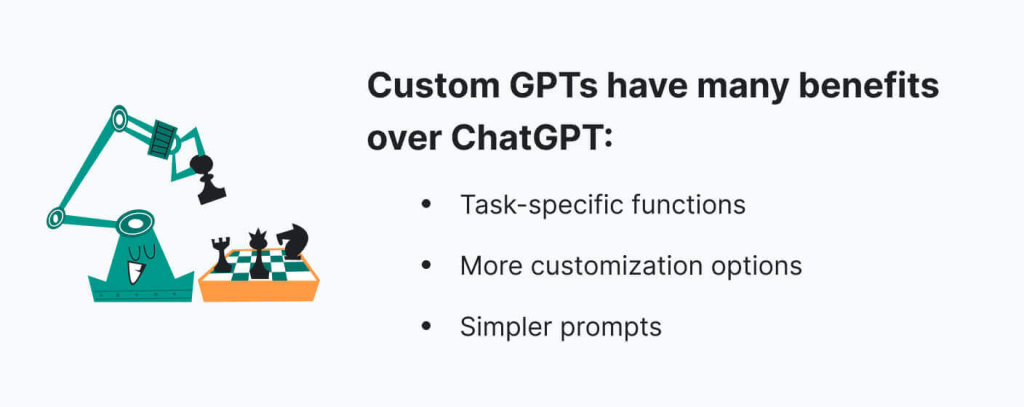
Note: To use these custom models, you need a subscription to ChatGPT Plus. For $20 a month, you will access the most advanced LLM to date and enjoy many additional functions.
- SciSpace GPT.
With this handy tool, you’ll have access to over 200 million academic articles right at your fingertips. SciSpace will give an accurate response to any scientific question and provide digestible summaries of research papers for a deeper study. - Consensus.
You can use this custom GPT to get an evidence-based answer to your question and conduct an in-depth literature search. Besides, Consensus can give you a proper bibliography list in the APA format. - Scholar GPT.
With this AI model, you can research millions of academic sources quickly and efficiently. Feel free to ask it for graphics, charts, and even real-time updates. It will also help you with problem-solving and NLP tasks. - Research-Paper Analyzer.
Want to have access to simplified summaries of complicated research papers? Try this GPT. It instantly extracts the main points of a study to facilitate easy comprehension. It can also analyze the credibility and relevance of a chosen paper. - Academic Research Reviewer.
Working with this GPT is like having a seasoned professor to help you refine your research paper. It will examine the depth of your literature review, underline the strengths and weaknesses of your paper, highlight gaps, and suggest areas for further research. - PubMed Buddy.
This GPT allows you to search for information in PubMed and UnPaywall databases. With PubMed Buddy, you’ll avoid going through countless irrelevant studies and have more time to spend on the more exciting research aspects. - Chemistry Lab Partner.
Get specific help on difficult chemistry questions with this tool. Analyzing data and explaining concepts are not the only functions of Chemistry Lab Partner. It can also assist with your lab work and even enable virtual experiments. - Graduate Level Physics GPT.
Try this custom GPT to make the advanced physics more understandable. It’s a practical tool that breaks complicated topics into brief and digestible explanations. Besides, it assists with physics problems and research. - Physics Tutor.
Do physics concepts seem too complex and intimidating to you? This GPT is here to sort things out. It will give simple and clear explanations understandable to physics students and laypeople who are just curious about how this world works. - Math Expert.
Working with this GPT is like having a helpful math tutor available anytime. It not only gives you a correct solution to any problem or equation but also provides a step-by-step explanation of how to get there.
💡 How to Use ChatGPT for Research: Key Takeaways
ChatGPT is a smart and helpful tool that can help you simplify some of the steps of your research process. You can use it to:
- Look for fresh and exciting topics,
- Create roadmaps,
- Find sources,
- Find real-life examples,
- Create research questions,
- Identify gaps in your outline,
- Summarize texts,
- Analyze statistics,
- Edit your writing,
- Create abstracts,
- Format the references.
One thing to remember is that relying on yourself is always a better option. Even though AI can save you lots of time, it still lacks ethical judgment, critical thinking, and expert knowledge in your field. If you decide to use ChatGPT in your research, make sure to double-check everything it produces and never use generated replies in your texts.
We hope you’ve found this article helpful and learned something new. Now, you know how to use ChatgGPT ethically, so you don’t have to worry about being caught. We suggest you check out your school’s guidelines before using the chatbot. Feel free to share your experiences working with AI tools in the comments below!
Want to know more about using ChatGPT in your studies? Check out our in-depth articles with tips on how to generate longer essays and make AI texts undetectable.
🔗 References
- How to Use ChatGPT to Do Research for Papers, Presentations, Studies, and More: ZDNet
- Three Ways to Leverage ChatGPT and Other Generative AI in Research: Times Higher Education
- The Top 10 Limitations of ChatGPT – Forbes
- Top 10 Drawbacks of Using ChatGPT in Academics: Analytics Insight
- The Best Custom GPTs to Make ChatGPT Even More Powerful: Digital Trends
- How to Use ChatGPT for Research and Essays: MakeUseOf
- Increase Your Creativity with ChatGPT – Psychology Today
- How Can I Use ChatGPT in My Research Work?: GitHub
- How to Use ChatGPT as a Research Tool: LinkedIn
- The Best AI Tools to Power Your Academic Research: Euronews
- ChatGPT and Fake Citations: Duke University


![187 Impressive Higher English Persuasive Essay Topics [2025]](https://ivypanda.com/blog/wp-content/uploads/2020/10/front-view-of-books-with-blue-background-309x208.jpg)
![227 Amazing College Persuasive Essay Topics & Speech Ideas [Free]](https://ivypanda.com/blog/wp-content/uploads/2020/10/teenager-student-girl-over-yellow-pointing-finger-to-the-side-309x208.jpg)